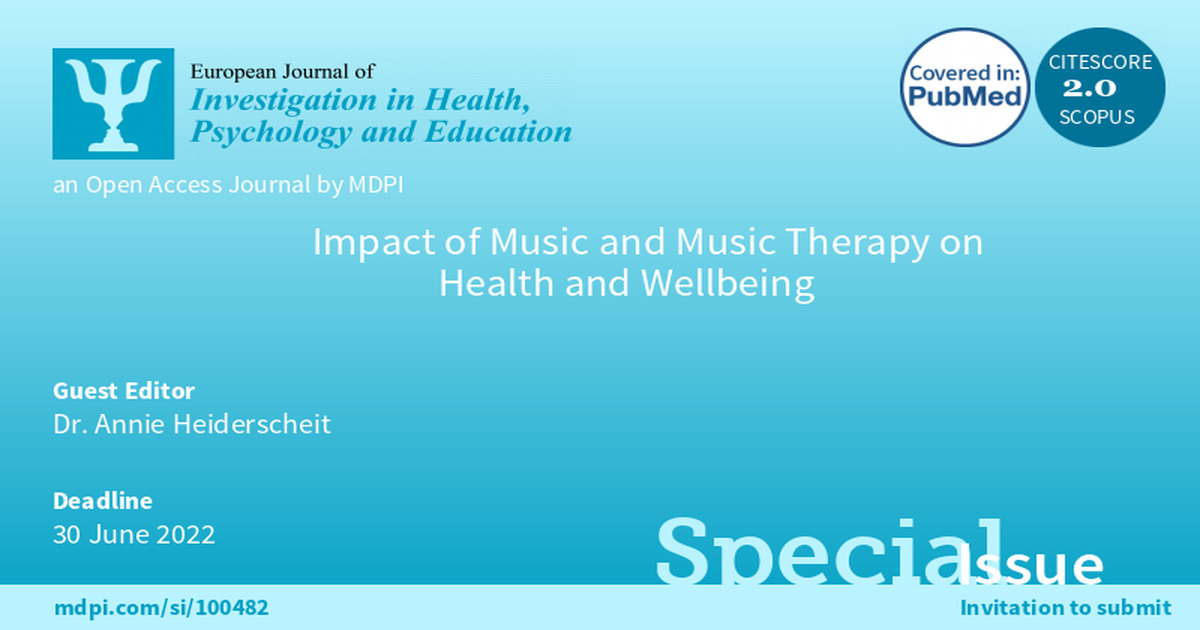Impact of Music and Music Therapy on Health and Wellbeing
A special issue of European Journal of Investigation in Health, Psychology and Education (ISSN 2254-9625).
Deadline for manuscript submissions: closed (30 June 2022) | Viewed by 27253

Special Issue Editor
Special Issue Information
Dear Colleagues,
Music has long been an integral resource for fostering health and wellbeing from primitive and Indigenous cultures to current and emerging practices. Music is a human experience that individuals across the lifespan can engage in and with. Music is also often a shared experience with groups and communities as well, fostering a sense of connection and belonging. Our collective experience of music further impacts its effect on health and wellbeing.
These multifaceted and unique features of music have prompted clinicians and researchers to explore and examine the role that music and music therapy plays in fostering aspects of health and wellbeing. This work ranges from the various ways human beings engage in experiencing, making, and creating music to how these different types of music experiences impact all the different dimensions of health and wellbeing.
Furthermore, thanks to technological advancements in mobile devices, digital music tools, streaming platforms, and adaptive devices, music has become more accessible than ever before. These have made music more accessible for everyday use and for research interventions alike. Advances in science have also propelled our understanding of the physiological and psychological impact of music.
In this Special Issue, we will focus on the many ways that music and music therapy are integral to fostering health and wellbeing with clients across the lifespan in healthcare and community-based settings. This issue will explore the myriad ways that music serves as a health resource supporting the many dimensions of wellbeing.
Best Regards,
Dr. Annie Heiderscheit
Guest Editor
Manuscript Submission Information
Manuscripts should be submitted online at www.mdpi.com by registering and logging in to this website. Once you are registered, click here to go to the submission form. Manuscripts can be submitted until the deadline. All submissions that pass pre-check are peer-reviewed. Accepted papers will be published continuously in the journal (as soon as accepted) and will be listed together on the special issue website. Research articles, review articles as well as short communications are invited. For planned papers, a title and short abstract (about 250 words) can be sent to the Editorial Office for assessment.
Submitted manuscripts should not have been published previously, nor be under consideration for publication elsewhere (except conference proceedings papers). All manuscripts are thoroughly refereed through a single-blind peer-review process. A guide for authors and other relevant information for submission of manuscripts is available on the Instructions for Authors page. European Journal of Investigation in Health, Psychology and Education is an international peer-reviewed open access monthly journal published by MDPI.
Please visit the Instructions for Authors page before submitting a manuscript. The Article Processing Charge (APC) for publication in this open access journal is 1600 CHF (Swiss Francs). Submitted papers should be well formatted and use good English. Authors may use MDPI's English editing service prior to publication or during author revisions.
Keywords
- music therapy
- music
- health and wellbeing
Benefits of Publishing in a Special Issue
- Ease of navigation: Grouping papers by topic helps scholars navigate broad scope journals more efficiently.
- Greater discoverability: Special Issues support the reach and impact of scientific research. Articles in Special Issues are more discoverable and cited more frequently.
- Expansion of research network: Special Issues facilitate connections among authors, fostering scientific collaborations.
- External promotion: Articles in Special Issues are often promoted through the journal's social media, increasing their visibility.
- Reprint: MDPI Books provides the opportunity to republish successful Special Issues in book format, both online and in print.
Further information on MDPI's Special Issue policies can be found here.






